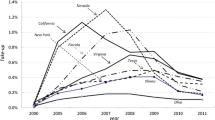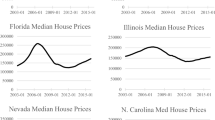Abstract
Maintenance and improvements affect house values and thus the observed pecuniary return. Whether due to lack of liquidity or the presence of strategic incentives, some borrowers have a higher probability of default and this could lead to lower maintenance and investment in the property. We test this hypothesis using a sample of properties on which we have repeat sales and mortgage information. We find that the predicted probability of default at the time of the original purchase significantly reduces subsequent observed pecuniary return. For instance, an increase in the probability of default from 22% to 32% leads to an 0.5% reduction in appreciation per year. Because the future house price varies with borrower risk, we examine many simulated scenarios to analyze the implications of the findings. From these scenarios, we observe that the highest risk borrowers can experience approximately 3% less appreciation per year than the lowest risk borrowers.
Similar content being viewed by others
Notes
In general, the true pecuniary return to the homeowner, which includes costs, may deviate greatly from the appreciation, which ignores costs. Moreover, a house tends to decline in price in the absence of improvements and maintenance. For example, Harding et al. (2007) estimated that without maintenance the price of a house tends to fall by 2.5% per year.
The “after-acquired mortgage clause” gives lenders a claim on property or improvements even if they occur after the inception of the mortgage (Arnold 1959).
When estimating the probability of default training model we also include origination years 2000 and 2001 to take advantage of our available mortgage data.
Of course, 90 day delinquency and foreclosure are closely related, but the difficulties of using foreclosures with their highly variable delays has led most empirical studies to use 90 day delinquency as the most operational empirical proxy.
References
Agarwal, S., Chang, Y., Yavas, A. (2012). Adverse selection in mortgage securitization. Journal of Financial Economics, 105(3), 640–660.
Agarwal, S., Ambrose, B., Yildirim, Y. (2015). The subprime virus. Real Estate Economics, 43(4), 891–915.
Ambrose, B.W., LaCour-Little, M., Sanders, A.B. (2005). Does regulatory capital arbitrage, reputation, or asymmetric information drive securitization? Journal of Financial Services Research, 28(1–3), 113–133.
Arnold, B.M. (1959). After-acquired property as mortgage security in Maryland. Maryland Law Review, 19, 294–319.
Aroul, R.R., & Hansz, J.A. (2014). The valuation impact on distressed residential transactions: anatomy of a housing price bubble. Journal of Real Estate Finance and Economics, 49, 277–302.
Behn, M., Haselmann, R., Wachtel, P. (2016). Procyclical capital regulation and lending. The Journal of Finance, 71(2), 919–956.
Boehm, T.P., & Ihlanfeldt, K.R. (1986). The improvement expenditures of urban homeowners: an empirical analysis. AREUEA Journal, 14(1), 48–60.
Campbell, J.Y., Giglio, S., Pathak, P. (2011). Forced sales and house prices. American Economic Review, 101(5), 2108–2131.
Davidoff, T. (2004). Maintenance and the home equity of the elderly. Fisher Center for Real Estate and Urban Economics Paper, Issue 03–288.
Demyanyk, Y., & Van Hemert, O. (2011). Understanding the subprime mortgage crisis. The Review of Financial Studies, 24(6), 1848–1880.
Deng, Y., Quigley, J.M., Van Order, R. (2000). Mortgage terminations, heterogeneity and the exercise of mortgage options. Econometrica, 68(2), 275–307.
Foster, T.B., & Kleit, R.G. (2015). The changing relationship between housing and inequality, 1980–2010. Housing Policy Debate, 25(1), 16–40.
Grinstein-Weiss, M., Key, C., Guo, S., Yeo, Y.H., Holub, K. (2013). Homeownership and wealth among low-and moderate-income households. Housing Policy Debate, 23(2), 259–279.
Harding, J., Miceli, T.J., Sirmans, C.F. (2000). Do owners take better care of their housing than renters Real Estate Economics, 28(4), 663–681.
Harding, J.P., Rosenthal, S.S., Sirmans, C.F. (2007). Depreciation of housing capital, maintenance, and house price inflation: Estimates from a repeat sales model. Journal of Urban Economics, 61(2), 193–217.
Herbert, C.E., McCue, D.T., Sanchez-Moyano, R. (2014). Is homeownership still an effective means of building wealth for low-income and minority households? (Was it ever?) Harvard University, Joint Center for Housing Studies.
Kau, J.B., Keenan, D.C., Yildirim, Y. (2009). Estimating default probabilities implicit in commercial mortgage backed securities (CMBS). The Journal of Real Estate Finance and Economics, 39(2), 107–117.
Kau, J.B., Keenan, D.C., Lyubimov, C. (2014). First mortgages, second mortgages, and their default. The Journal of Real Estate Finance and Economics, 48 (4), 561–588.
Koo, R., & Sasaki, M. (2008). Obstacles to affluence: thoughts on Japanese housing. NRI Papers 137.
Kumar, A. (2015). Do restrictions on home equity extraction contribute to lower mortgage defaults? Evidence from a policy discontinuity at the Texas border. Federal Reserve Bank of Dallas working paper 1410.
Laufer, S. (2018). Equity extraction and mortgage default. Review of Economic Dynamics, 28, 1–33.
Mankiw, G., & Weil, D. (1989). The baby boom, the baby bust, and the housing market. Regional Science and Urban Economics, 19, 235–258.
Ortalo-Magné, F., & Prat, A. (2014). On the political economy of urban growth: homeownership versus affordability. American Economic Journal: Microeconomics, 6 (1), 154–181.
Pitkin, J.R., & Myers, D. (1994). The specification of demographic effects on housing demand: avoiding the age-cohort fallacy. Journal of Housing Economics, 3 (3), 240–250.
Quercia, R. (1997). House value appreciation among older homeowners: implications for reverse mortgage programs. Journal of Housing Research, 8, 201–223.
Tanaka, M. (2008). Essays on durability and the Japanese housing market. John Hopkins University.
Turnbull, G.K., & Zahirovic-Herbert, V. (2012). The transitory and legacy effects of the rental externality on house price and liquidity. The Journal of Real Estate Finance and Economics, 44(3), 275–297.
Acknowledgments
We thank the editors and referee for helpful comments. Hayunga gratefully acknowledges financial support from the Terry-Sanford Research Award.
Author information
Authors and Affiliations
Corresponding author
Rights and permissions
About this article
Cite this article
Hayunga, D.K., Pace, R.K. & Zhu, S. Borrower Risk and Housing Price Appreciation. J Real Estate Finan Econ 58, 544–566 (2019). https://doi.org/10.1007/s11146-018-9669-9
Published:
Issue Date:
DOI: https://doi.org/10.1007/s11146-018-9669-9




